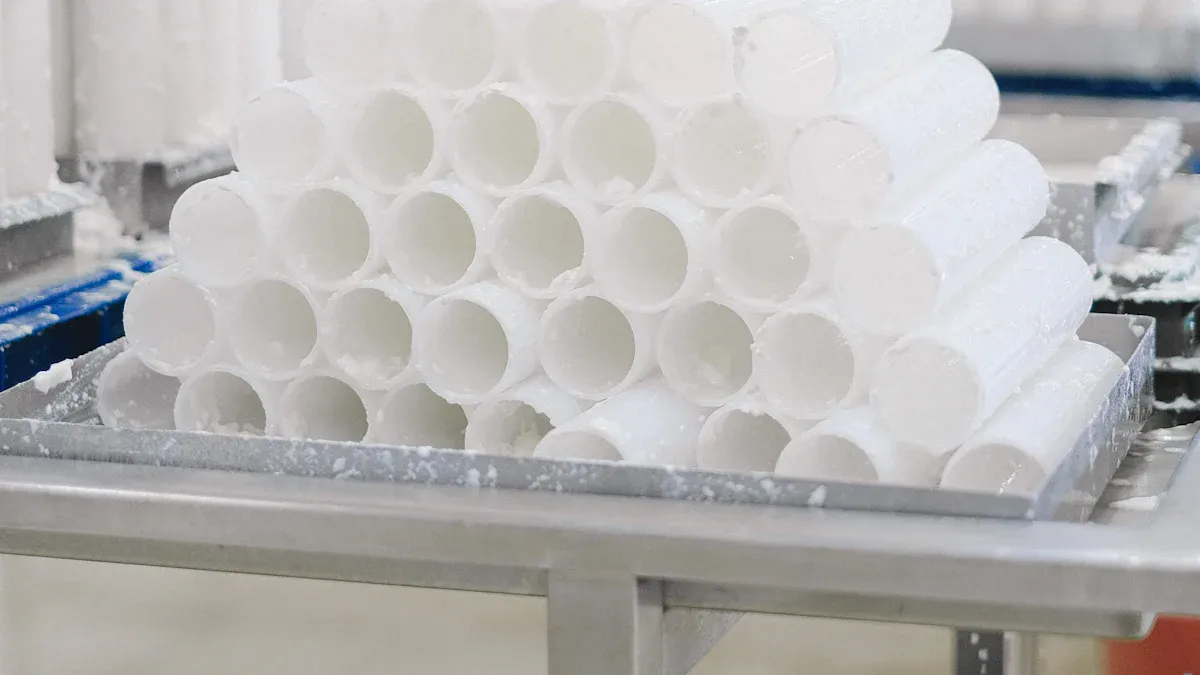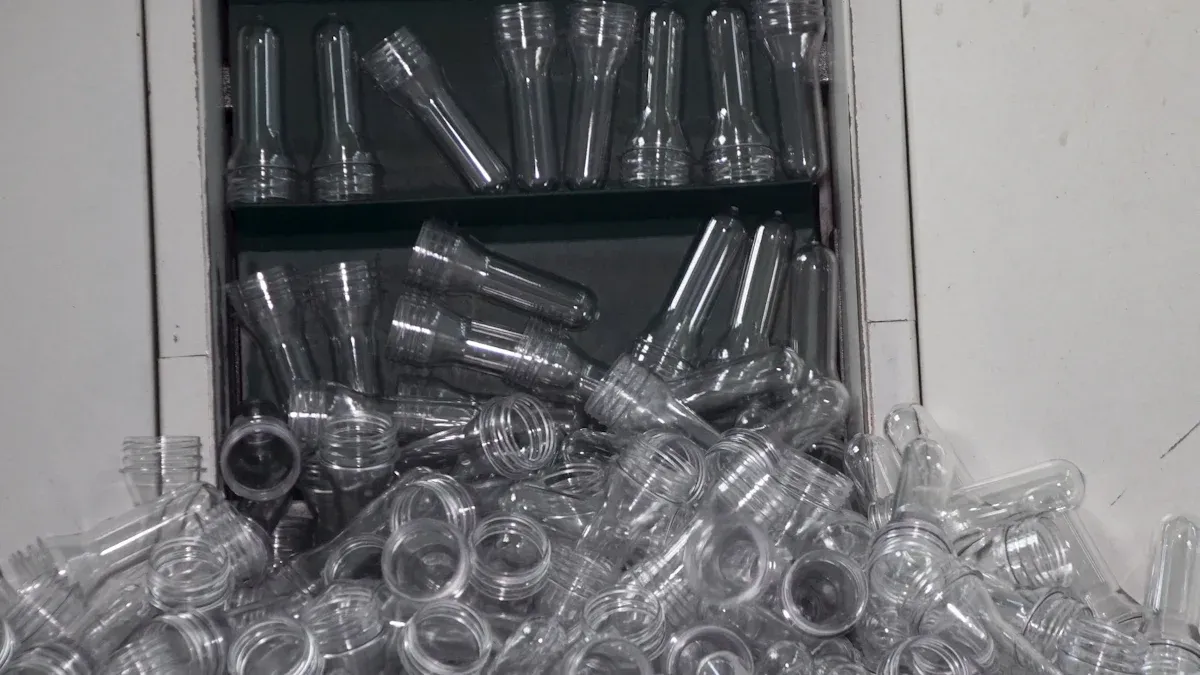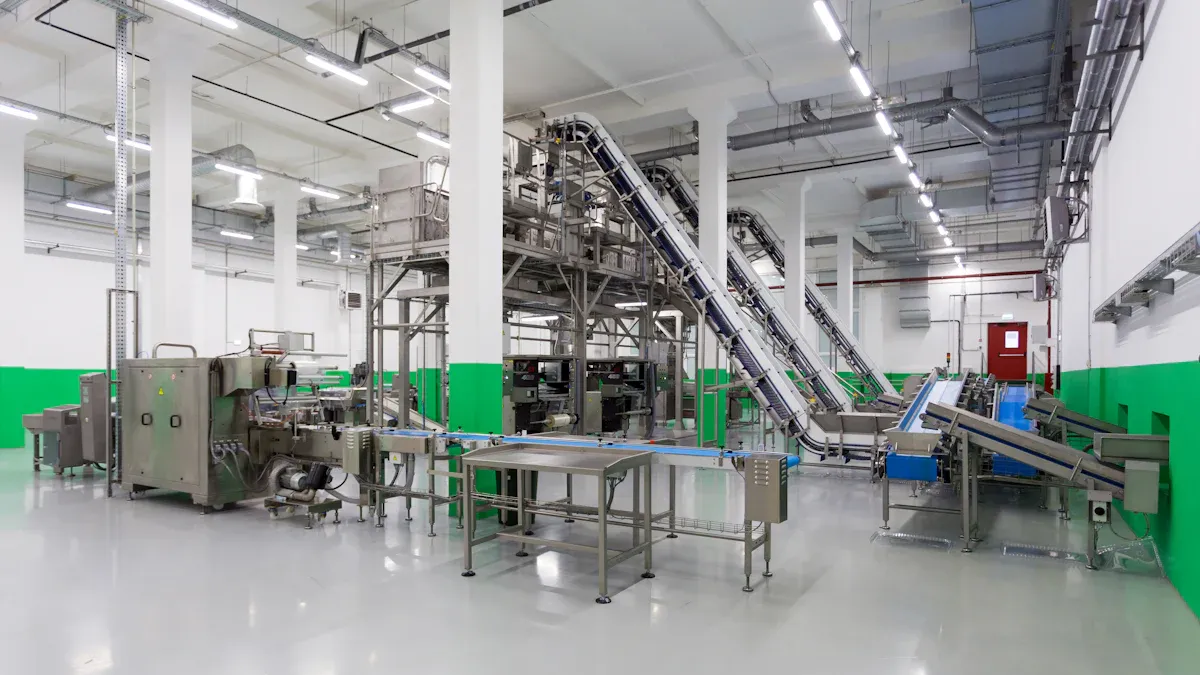
Design for manufacturability (DFM) focuses on creating parts that are easy and cost-effective to produce. In plastic injection molding, DFM considerations ensure your designs minimize waste and reduce production costs while maintaining high-quality standards. For example, optimizing the design can conserve materials, simplify assembly, and lower labor expenses. These improvements not only save money but also streamline production processes. Addressing DFM early in the design phase allows you to identify potential challenges and make adjustments before they become costly issues. This proactive approach results in better efficiency and superior end products.

Draft angles play a critical role in the manufacturing process of plastic injection molded parts. These angles are slight tapers added to the vertical walls of a part to ensure smooth ejection from the mold. Without proper draft angles, parts can stick to the mold, causing damage or defects during removal. You can think of draft angles as a way to reduce friction between the part and the mold surface. This simple design adjustment improves manufacturability and ensures consistent production quality.
The ideal draft angle depends on the material used for your injection-molded parts. Different materials shrink and behave differently during the cooling process, which affects how easily they release from the mold. Below is a table summarizing recommended minimum draft angles for common materials:
| Material Type | Minimum Draft Angle |
|---|---|
| ABS | 1.5° |
| Polycarbonate | 1° |
| Polypropylene | 0.5° |
| Glass-Filled Materials | 2° – 3° |
When designing your parts, always consider the material's properties and follow these guidelines to avoid complications during the manufacturing process.
Insufficient draft angles can lead to several issues, including surface scratches, warping, or even part breakage during ejection. These defects not only compromise the quality of your injection-molded parts but also increase production costs due to rework or scrap. To prevent these problems, ensure that all vertical surfaces in your mold design include adequate draft angles. Collaborating with your manufacturer early in the design phase can help you identify potential trouble spots and optimize your design for smooth ejection.
Tip: Always test your design through prototyping to validate the effectiveness of your draft angles before full-scale production.
Maintaining consistent wall thickness is crucial for producing high-quality parts in plastic injection molding. Uneven thickness can lead to defects such as warping, sink marks, and structural weaknesses. Consistency ensures that the material flows evenly during the molding process, reducing the risk of air traps and weld lines. Uniform cooling is another benefit, as plastics are poor heat conductors. When the walls cool evenly, residual stresses decrease, which enhances the strength and durability of the parts. Proper design, material selection, and process control are essential to achieving this consistency.
Tip: Collaborate with your manufacturer early in the design phase to identify areas where wall thickness might vary and adjust accordingly.
Different materials require specific wall thicknesses to optimize manufacturability and part quality. For example, thicker walls cool more slowly, which can extend production time. An increase of just 1mm in wall thickness may require an additional 5 to 10 seconds of holding time. For a product with a 3mm wall thickness, this could mean an extra 10 to 20 seconds compared to a 1mm thick product. These differences highlight the importance of understanding your material's properties during the design phase. Consulting material guidelines and testing prototypes can help you determine the ideal thickness for your injection-molded parts.
Proper wall design plays a significant role in preventing sink marks and warping. Non-uniform thickness causes irregular cooling, leading to shrinkage and sink marks. Even areas with uniform thickness can develop sink marks if they are excessively thick. To minimize these issues, ribs should be about 60% of the wall thickness. Uneven walls can also cause warping due to differential cooling rates. By designing walls with consistent and appropriate thickness, you can maintain structural integrity and improve part quality.
Note: Prototyping is an effective way to validate your wall thickness design and ensure manufacturability before full-scale production.
Undercuts in mold design can complicate the injection molding process. These features, such as holes or recesses that prevent straight ejection, require additional mechanisms like sliders or lifters. Without addressing undercuts, you may face increased mold complexity, longer cycle times, and higher production costs. For example, incorporating lifter mechanisms can improve mold efficiency by reducing cycle times and increasing throughput. Simplifying product design to minimize undercuts leads to smoother production and better part quality.
| Evidence Description | Impact on Manufacturing Efficiency |
|---|---|
| Reducing undercuts simplifies injection molding processes. | Eases production by minimizing mold complexity. |
| Incorporating lifter mechanisms enhances mold efficiency. | Reduces cycle times and increases throughput. |
| Simplifying product design by addressing undercuts leads to smoother production. | Results in reduced costs and improved product quality. |
You can reduce the impact of undercuts by optimizing your design and material selection. Numerical analysis during the injection process helps you choose the right materials and design parameters. Factors like wall thickness, surface inclination, and undercut geometry must be carefully adjusted to ensure proper mold filling and geometric accuracy. Reliable locking mechanisms for sliders, such as mechanical or hydraulic locks, also play a crucial role. These mechanisms prevent displacement and defects, enhancing the efficiency of the molding process.
Parting lines, where two halves of the mold meet, significantly affect manufacturability and part quality. Poorly placed parting lines can lead to flash, misalignment, or visible marks on the molded parts. To optimize parting lines, align them with the natural geometry of the part. This reduces the risk of defects and simplifies the mold design. Collaborating with your manufacturer during the design phase ensures the parting lines are strategically placed for both functionality and aesthetics.
Tip: Always prototype your design to validate parting line placement and ensure smooth production.
Choosing the right material is essential for creating durable and functional injection-molded parts. Several factors influence material selection, including mechanical properties, chemical resistance, thermal stability, and cost. For example, materials with high impact resistance, such as polycarbonate (PC), are ideal for applications requiring durability. On the other hand, polypropylene (PP) offers excellent chemical resistance, making it suitable for healthcare or aerospace uses.
| Factor | Description |
|---|---|
| Mechanical properties | Includes strength, resistance, and elasticity, crucial for product sustainability. |
| Chemical resistance | Essential for applications exposed to harsh chemicals, particularly in healthcare and aerospace. |
| Thermal properties | Important for materials used in electronics, requiring heat resistance and stability. |
| Cost considerations | Material cost and availability must align with budget constraints for effective design. |
Understanding these factors helps you balance performance and cost, ensuring your parts meet both functional and budgetary requirements.
Material shrinkage is a critical consideration in the injection molding process. Plastics shrink as they cool, which can affect the final dimensions of your parts. For instance, materials like nylon exhibit higher shrinkage rates compared to ABS or PC. To manage shrinkage effectively, you should account for it during mold design. Collaborating with your manufacturer ensures the mold compensates for material-specific shrinkage, reducing the risk of dimensional inaccuracies.
Using a material with predictable shrinkage behavior, such as ABS, can simplify production. Additionally, testing prototypes allows you to identify and address shrinkage-related issues before full-scale manufacturing begins.
Material testing and validation ensure your parts meet performance and quality standards. Testing methods like tensile strength and durability testing provide valuable insights into how materials behave under stress. For example, parts molded with Sevrene 3000-90A demonstrated a 20% improvement in tensile strength compared to 70A materials. These tests also revealed that 90A parts endured 50% more cycles before failure, highlighting their superior durability.
| Testing Methodology | Outcome |
|---|---|
| Tensile Strength Testing | Parts molded with Sevrene 3000-90A showed a 20% improvement in tensile strength over 70A. |
| Durability Testing | Sevrene 3000-90A parts endured 50% more cycles than 70A parts before failure. |
| Dimensional Accuracy | All parts met tight dimensional tolerances without the need for post-molding adjustments. |
By validating materials through rigorous testing, you can ensure your parts perform reliably in their intended applications. This step minimizes production risks and enhances overall quality.

Gate placement plays a vital role in the injection molding process. The gate acts as the entry point for molten plastic, regulating its flow into the mold cavities. Proper placement ensures the material fills the cavities evenly, reducing defects like gaps or short shots. When you position the gate at the thickest section of the part, it allows the molten plastic to retain heat longer. This ensures consistent pressure during cooling and minimizes the risk of defects. Selecting the optimal gate location improves flow dynamics, enhances cooling, and maintains the integrity of the molded parts.
Gate placement also affects the appearance of your injection-molded parts. Poorly positioned gates can leave visible marks or blemishes on the surface, impacting the overall aesthetics. To avoid this, you should place gates in areas that are less visible or easy to conceal, such as the underside of the part. For products requiring a polished finish, consider using specialized gate designs that minimize surface imperfections. Collaborating with your manufacturer during mold design helps you balance functionality and aesthetics effectively.
Tip: Always prototype your design to evaluate the visual impact of gate placement before moving to full-scale production.
Following industry benchmarks ensures optimal gate design and placement. Position gates carefully to achieve uniform material flow and prevent defects like weld lines or air traps. Placing gates at the thickest section of the part enhances cooling consistency and reduces cycle time. Below is a table summarizing best practices for gate placement:
| Aspect | Best Practice |
|---|---|
| Gate Location | Position gates carefully to ensure uniform material flow and to avoid defects. |
| Defect Prevention | Avoid issues like weld lines, air traps, or uneven cooling. |
| Quality Improvement | An optimal gate location enhances part quality and reduces cycle time. |
By adhering to these practices, you can improve the quality of your molded parts while optimizing production efficiency.
Ejector pins play a vital role in removing parts from the mold without causing damage. Proper placement ensures smooth ejection and prevents defects like warping or scratches. You should position ejector pins on flat surfaces or areas with less aesthetic importance to avoid visible marks. Uneven placement can lead to imbalanced ejection forces, which may distort the part. Collaborating with your manufacturer during mold design helps you determine the optimal locations for ejector pins. This step ensures your molded parts maintain their structural integrity and visual appeal.
Tip: Use prototyping to test ejector pin placement and refine your design for better manufacturability.
The surface finish of injection-molded parts affects both their performance and appearance. A smooth finish reduces friction, enhances wear resistance, and improves corrosion protection. These factors contribute to the part's functionality and longevity. On the aesthetic side, a polished surface boosts the visual appeal and marketability of your product. Below is a table summarizing the impact of surface finish:
| Aspect | Impact on Functionality | Impact on Aesthetics |
|---|---|---|
| Friction | Influences performance | |
| Wear | Affects durability | |
| Corrosion Resistance | Enhances longevity | |
| Smooth Finish | Improves aesthetic appeal | |
| Marketability | Increases marketability |
To achieve the desired surface finish, you should consider the material properties and mold design. Collaborating with your manufacturer ensures the finish meets both functional and aesthetic requirements.
Note: Surface finish is essential for performance and significantly impacts the aesthetic appeal of your parts.
Prototyping is a critical step in ensuring your design meets manufacturability and quality standards. By creating prototypes, you can identify potential issues early and make necessary adjustments before full-scale production. For example, prototyping confirms that parts meet functional requirements and adhere to DFM tips. It also helps you validate tolerance analysis, ensuring proper alignment and fit in assemblies. The table below highlights the benefits of prototyping:
| Improvement Type | Description |
|---|---|
| Design for Manufacturability (DFM) | Following DFM guidelines enhances moldability and reduces machining costs for mold components. |
| Tolerance Analysis | Using statistical tolerance analysis methods prevents issues with alignment and fit in assemblies. |
| Prototyping Benefits | Prototyping confirms that parts meet functional and quality requirements before production. |
By incorporating prototyping into your process, you can reduce production risks and improve the overall quality of your molded parts.
Understanding DFM considerations is essential for optimizing plastic injection molding. By focusing on manufacturability, you can reduce costs, improve part quality, and streamline production. For example, adhering to manufacturing standards minimizes unnecessary expenses and shortens development cycles, helping you bring products to market faster. These principles also enhance part quality by addressing potential design flaws early.
Collaborating with manufacturers during the design phase ensures your parts meet functional and aesthetic requirements. This partnership allows you to refine designs, validate prototypes, and achieve superior results. Applying DFM principles not only saves time and money but also ensures your parts perform reliably in their intended applications.
DFM ensures your designs are optimized for efficient manufacturing. It helps you reduce production costs, improve part quality, and avoid defects. By addressing potential issues early, you can streamline the molding process and achieve better results.
Draft angles make it easier to eject parts from the mold. Without them, parts may stick, causing scratches or damage. Adding proper draft angles reduces friction, improves surface finish, and ensures consistent quality.
Consistent wall thickness prevents defects like warping and sink marks. It ensures even material flow and cooling during molding. This improves the structural integrity and appearance of your parts.
You can reduce undercuts by simplifying your design. Avoid features like deep recesses or complex geometries. Collaborate with your manufacturer to explore alternative solutions, such as side actions or collapsible cores.
Focus on mechanical properties, thermal stability, and chemical resistance. Choose materials that suit your part's function and environment. Testing and validation ensure your material performs as expected.
Tip: Always consult material guidelines to match your design requirements.